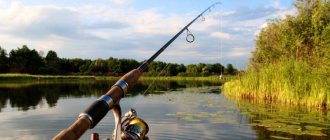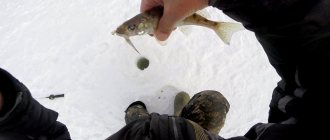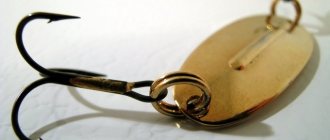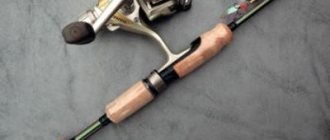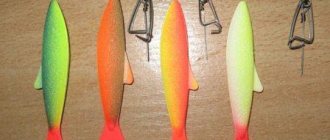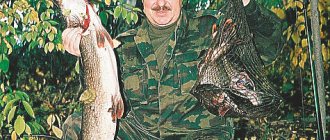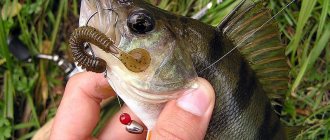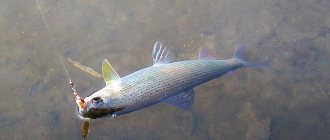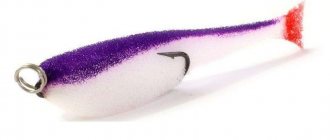Types of pike spoons and their features
In the modern world there is a wide variety of lures for pike, but real fishermen always have a spinner in their arsenal, since pike are caught with it all year round.
Spoons for pike are divided into two main classes:
- Oscillating spinners.
- Rotating spinners.
Oscillating spoons or short oscillators are made of a metal plate in a slightly curved form, and when inserted, they begin to waddle, move from side to side, in a word, oscillate, hence their name. Oscillating spoons are popular because they have a number of advantages:
- universal spinner. You can use it both in calm bodies of water and in strong currents;
- used in hard to reach places. The spoons provide little resistance, as they have the shape of a curved plate, so you can catch pike with it even in the most inaccessible places;
- ease of use. Using this spinner, you don’t need any skills, you just need to throw the spinning rod and pull it towards you, the spinner itself will begin to “play” in the water.
Rating of oscillating lures for pike in the video below:
A spinner or simply a spinner consists of a wire rod, a metal petal, which rotates around the center (rod) when retrieved, and a treble hook. Turntables also have several advantages:
- ease of use. Even a beginner can handle such a spinner; no knowledge is needed;
- vibrations created. The appearance of the spoons is not similar to any other fish, therefore it is the vibrations created that attract the pike.
Photo: Spoons for pike and their varieties
Spinner fishing
A lot can be said about the technique of catching fish with oscillating and rotating spoons. Very often you hear from fishermen, hung from head to toe with the most modern baits, that these spoons are already a thing of the past and they do not have much catchability. But, as practice shows, the time for these baits has not yet come - sometimes pike prefer a simple and proven piece of iron, and the fishing technique with it is not so simple. Anyone can cast it and reel the line back onto the reel, but not everyone can force a predator to attack it. It is important to decide where and under what conditions to use the “turntable” and where the “oscillator”. As a rule, they fish with spinners and use them in deeper waters.
When using such spinners, beginners make the same mistake: they try to catch fish with a quick retrieve. Basically, these fast movements are caused by the fear of losing the lure. And it’s really very easy to lose it, since in the fishing areas there can certainly be “pitfalls” in the form of various snags. This way you can constantly throw the same lure, but you may not see the fish. Pike, for example, does not like fast retrieves and in order to catch it, it is recommended to use a very slow retrieve to the point of failure or stop for 1-2 seconds. Usually it attacks the bait while stopping. In this case, the pike can attack it both at the very bottom and in the water column. In this case, you can stop the “turntables” for a short time, and the “oscillators” for much longer, right up to laying it on the bottom. At the same time, it will slowly lower, making oscillatory movements from side to side. At this moment, she can become the prey of a predator. If the fish did not take it during the fall, then already at the moment of the fall, when the bait raises a cloud of dust, the predator may definitely become interested in it.
Closer to autumn, predatory fish try to go deeper and this is where oscillating spoons can go unnoticed. In some bodies of water with stagnant water, pike take better with spoons than with other baits. The fact of such “amateurism” is difficult to explain.
Very often, beginning spinning anglers repeat another mistake - they start fishing the territory with a long cast. Practice and experience tell a completely different story - you need to start fishing in shallow water, and then move to depth. Very often a predator stands near the shore and a long cast can ruin everything, especially if during retrieving you get a hook or manage to pull out a small log with vegetation. At this point you can no longer cast. It will be worse if the bait remains on the bottom from the first cast.
In short, the technique of fishing with spoons is as follows: the bait is thrown and slowly carried along the bottom or in the water column. It should be recalled that the speed of the retrieve is a determining factor when fishing with spoons, which cannot be neglected. Although there are many cases when pike attacked the bait even with fast, aggressive fishing. It all depends on the quality of the spinner. The main thing is that when the speed of the retrieve increases, it does not lose its game. The ones most susceptible to this problem are “oscillators,” and as for “turntables,” when the wiring increases, they simply fly out of the water without losing play.
Oscillating spinners of the “Atom” type begin to rotate around their own axis when the fishing speed increases. This indicates that the spinner is not of high quality. When there was an abundance of fish in rivers and lakes, perhaps predators rushed to such a game of bait. Nowadays, when fish are caught with all legal and illegal gear, such a game of spinning does not work. There are fewer fish and they have become “smarter.”
An amateur fisherman should have 3-4 models of spinners of different weights and different shapes in his arsenal. There is no point in having more, because each one requires its own wiring technique. It is best to master the wiring technique with these 3-4 models. In this case, they can give more fish than a whole box of all kinds of baits. When throwing away this or that model, it’s worth experimenting with the wiring to catch the moment of truth. It happens that fishermen undeservedly ignore some lure, believing that it is not very catchy. Having thrown everything, but to no avail, the fisherman finally decides to throw this lure too. After 2 or 3 casts, it turns out that the spoon works great and produces fish. Using your own, although not large, arsenal, you should adapt to each bait individually and feel its work.
The “oscillator” can be successfully used for jigging both at the very bottom and in the water column. Elongated baits are suitable for this, as they create minimal resistance in the water. This way you can successfully catch pike, perch and even chub.
When fishing with lures, their color plays a big role. Natural colors have been used in the recent and distant past. That is, the color of the bait corresponded to the color of the metal from which it was made. As a rule, these were copper, brass, and silver. It is also possible that there were also gold spoons, although there is no information about this. For another 10-15 years there were much more fish in rivers and lakes, and they successfully chased brass, copper and “silver” baits. At the moment there are fewer fish and they have become more picky. Manufacturers of spinners also do not stand still and offer fishermen a huge number of colors. Modern technologies are increasingly being used in production. Laser technology is successfully used to obtain a three-dimensional pattern on the body of the spinner. This produces results, but they are very expensive. When choosing the color of the spinner, you need to take into account the background of the environment, as well as weather conditions. In cloudy weather, it is advisable to use brighter colors, and in sunny weather, duller ones, so that the body of the spinner does not produce “bunnies”.
Lures that are not monochromatic, but two-color or even multi-colored, are very popular. In addition, the fish are partial to spinners, which make all sorts of sounds when retrieved. Usually, such baits are very catchy. In two-color lures, the body of the spoon is painted on both sides and has 2 or more colors. Usually these are multi-colored dots or stripes, but there can also be intricate geometric shapes.
When fishing with spoons, it is worth experimenting with their size. Size matters too. It is believed that pike prefers to grab larger prey so as not to waste its energy on small things. Many spinning fishing experts do not recommend going out for pike with small lures. A good pike (about a kilogram) can easily swallow a bait the size of a palm. When hunting for pike, it is advisable to use spinners of at least number 3. If it is very hot, you can use “turntables” and number 2.
To catch other fish, for example, perch, asp, chub, much smaller spoons are used. If we talk about perch and asp, they mainly prefer small fish. Many amateur fishermen have noticed how an asp walks along the shore and “beats” the fry, that is, drowns them out, and then collects them. Usually he walks alone around his territory and feeds. Perch, on the contrary, is a schooling fish and they hunt for “trifles” in groups. To catch these predators, “ultralight” baits are usually used. You can catch chub and ide with this type of bait. There were cases when such baits were attacked (and caught) by a silver bream.
You can use spoons for fishing all year round, as long as you have access to water. In cold water, fish prefer spinners, since they stop responding to high-quality emissions from spinners. “Oscillators” of number 3 or more are suitable for this purpose.
Most likely, the time of the oscillators has not yet passed, and never will: the way fish were caught on them will continue to be caught. Moreover, the “turntables” manage not to remain in place, but move forward. It is appropriate to note here that a scientific approach and modern technologies are used in production. Increasingly, multi-colored holographic patterns are being created on the petals of “turntables” and on the body of “oscillators”. When they fall into the water, they create a three-dimensional image that does not go unnoticed by the predator. Such baits are super catchy.
These types of spinners are trying to push other types of baits out of the market: these are “wobblers and poppers,” but especially silicone baits. Wobblers are fish-shaped baits with different colors. Wobblers, especially oblong ones, are very suitable for twitching. Silicone baits are used for “jigging” and “micro-jigging” wiring. Poppers are similar to wobblers, but they are designed for surface retrieval. But it’s worth paying special attention to silicones. These are baits in the form of fish, bugs and worms with a very wide range of colors. Recently, toads, mice, and crustaceans have appeared. The material for their manufacture is silicone. Recently, they have begun to use “edible” silicone. Another argument for the constant improvement of oscillating and rotating spinners.
Unhooked
There is another type of spinner - non-hooking. This lure is designed in such a way that during the retrieve the hooks are hidden and open only during the bite. Many experienced fishermen are wary of non-hook baits, as they believe that this spoon makes a lot of empty hooks. However, it still has its advantage - fishing for pike in hard-to-reach places, for example among dense thickets, shallow water, and wetlands.
Design features of cicadas
When purchasing a cicada, anglers pay attention to some differences in design.
Of particular interest are the holes for attaching to equipment on the back of the spoon.
- Models with three holes allow the angler to shift the center of gravity of the bait. In this case, not only the play of the spinner changes, but the depth of its immersion and the speed of its fall.
If you use the outermost hole at the tail, the cicada begins to play widely and sweepingly in the water.
When hanging the same model from the extreme front hole, you can get fast and crushing play in the horizontal plane.
The middle hole is sometimes the most catchable due to the optimal balance of fall speed and amplitude. Cicadas with one hole and two tees resemble a kind of rocker. This bait works excellently in the vertical plane, flies far when casting, and vibrates strongly during retrieval.
The predator is best caught using such a cicada from a boat in a plumb line or from under the ice.
Success in catching a predator with a cicada also depends on the precisely chosen fishing location. Experienced fishermen advise using the lure near thickets of grass.
Small hooks of the spoon create special turbulences in the water, and small insects and debris fall from algae and water lilies, attracting the attention of a predator. In such areas of the reservoir, the fisherman may be in wait for trophy specimens, the fight with which will cause a lot of unforgettable emotions.
Popular manufacturers of spinners
Spoons take an active part in fishing. If you buy a low-quality lure, you can really regret it. So that you don’t have any problems choosing manufacturers, we will share with you the 5 best manufacturers of spinners and their prices, so that you can know approximately how much their products cost.
- Canadian Williams spinners. These spoons are popular because they have perfect play in the water and a natural shine that pike loves so much. The main distinguishing feature of Williams spinners is that they are made of high quality brass and coated with precious metals - silver and gold. Who would have thought that such a combination would become popular in the fishing market. Such spinners can be bought for a very reasonable price, from 300 to 1500 rubles.
- Mepps (Meps) - French-made spinners. The company has been on the market for more than 80 years, during which time it has earned itself an excellent reputation. Most anglers choose Mepps spinners and appreciate them for the quality, play and shine of the spinners. Prices for these spoons start from 90 rubles.
- Atom. Legend of domestic fishing. The company appeared in the 50s of the last century and still exists. Spinner spoons from this manufacturer are valued for their range, catchability and inexpensive prices. Almost every third angler has an Atom spinner. Anyone can afford such working spinners, because their prices are very low, starting from 50 rubles.
- Rapala spinners from a Finnish manufacturer. The company’s entire product range consists of almost one spinner – Rapala Minnow Spoon (Rapala RMS). This spoon is notable for the fact that it consists of plastic and has one hook, which is protected from snags. You can buy a spinner for around 260-600 rubles.
- Kuusamo (Kuusamo) is a Finnish manufacturer of spinners. These lures differ in the production process. They are completely handmade and go through 13 stages of painting. But besides this, they attract attention with their sophisticated oscillating game, luring the pike more and more. Prices for this manufacturer range from 300 to 800 rubles.
About
Making cicada spoons at home
With an abundance of spinners in stores, fishermen often make cicadas themselves. First, prepare diagrams and drawings of the bait.
Tools used
To make a spinner at home you need to have some tools:
- bench vise with jaws;
- wire cutters;
- pliers and round nose pliers;
- hammer;
- files;
- chisel;
- sandpaper;
- jigsaw for metal and spare saws for it;
- needle files of different types;
- drill and twist drills with a diameter of 1.5-2.5 mm;
- scissors for cutting metal.
When making cicada spinners with your own hands, they use sheet metal. More often they choose a hard material, it can be brass or stainless steel. Sheet thickness - 0.7-0.8 mm.
To create homemade gear for catching predators, ready-made petals from “long” spinners number 1+ according to the MEPS classification are also suitable. The sinker is made of lead. Hooks choose double or triple.
Manufacturing process
The manufacturing technology is simple, the process consists of several stages:
- a drawing of the future bait is applied to the prepared sheet metal using a needle;
- Using metal scissors, the workpiece is cut out according to the applied pattern;
- finishing of the contours is carried out with a needle file or a file;
- drill holes for the fishing line at a distance of 2 mm from the edge of the workpiece;
- if the dimensions of the workpiece are small, you can make one hole for fastening;
- make a hole for the tee, its size should allow the winding ring to dangle freely;
- roughness is cleaned with a file, the body of the bait is polished to a shine with zero-grade sandpaper and Goya paste.
For a lead sinker, pellets are poured with a cut for fastening, or a diamond-shaped “roller” is used, weighing 5-7 g, sawn lengthwise with a hacksaw or metal jigsaw. The sinker is glued to the lure with waterproof glue; for better grip, it is pressed to the workpiece with pliers.
The double hook is placed with the tips backwards; it does not require a winding ring.
How to improve the spinner
Homemade gear improvements improve catchability by 50%. The standard doubles that come with the bait are used on spinning rods for summer fishing. In winter they are replaced by larger specimens. The hooks are sharpened with a file for sharpness; this technique reduces the number of fish hatches.
The body of the spinner is painted in yellowish shades and holographic stickers are added. The cicada is covered with a phosphor, which is fixed with quick-drying varnish, an eye is drawn with a marker, and woolen threads or twisters are added.
How to choose a lure for pike
As we have already said, pike can be caught all year round; therefore, it is better to choose a spoon according to the seasons, because each season has its own nuances.
- Summer is not the peak of activity. In summer, the most effective fishing will be with a rotating spoon. Another important nuance for a good catch is that in very hot weather the spoons should be slightly smaller. The best spinner size in summer starts from 5 cm in length, but if you want to catch a larger pike, you can take a bait 10-15 cm long.
- Autumn is the peak of activity. During this period, the pike tries to gain weight and fat for the winter. In the fall, it can be caught with any type of spinner; as for the size, there is a high probability of catching fish with large spinners, from 10 cm in length. The bait should be applied in steps or evenly, perhaps even with pauses.
- Winter is low activity. During this period, the pike leads a passive lifestyle. Therefore, when catching it, most likely you will have to wait a long time for the result. It is better to make holes in places where the bottom is heterogeneous (pits, currents). The optimal spinner size is 5-10 cm.
- Spring - increased activity. During this period, the pike will not quickly chase the prey, so it is better to move the bait slowly. Vibrators 5-8 cm long are best suited.
About
Features of catching pike with a spinner depending on the season
The toothy predator is caught all year round, but not all spinning rods are suitable for winter fishing. For this time of year, your own gear and bait are suitable. Despite this, there is a rating of spinners used in winter.
- "Baron" - well suited for first ice. It has good play at shallow depths and is very easy to use.
- "Castmaster" - used at great depths and in strong currents. Has a holographic sticker that attracts predators. Huge selection of colors and sizes, but low cost. Suitable for any budget!
- “Atom-2” is easy to make, so you can do it yourself. It performs well when retrieved slowly and increases the chances of an excellent catch.
- “Cicada” plays believably and is easy to make. It's worth trying to make it yourself!
- Nautilus - this spinner comes in an original shape and two types of play.
In autumn, spring and summer, successful fishing is guaranteed. Just what features does each season have?
Spring
It’s great luck to catch the spring pike feast: it lasts from mid-March to early April. The best spinner for fishing at this time of year is a oscillating one.
It must be light and small. Approximate size: 4–8 centimeters.
You can use bait of standard colors: silver or copper. It is better to conduct the retrieve slowly, as the predator will not chase fast fish.
Reference! Spring is the period of pike spawning. Before this, her belly is filled with caviar, and after that she becomes lazy and has no strength left for a quick hunt. Try to fish slowly, without sudden movements.
Summer
During this period, it is worth using rotating and oscillating spoons. With the onset of summer, pike changes its activity and hunts for larger fish. But on hot days, its activity decreases, and small fish representatives again become prey.
It is recommended to take both large and small baits with you. The optimal sizes are from 5 to 10 centimeters. We choose the color depending on the weather. An important criterion is the dullness of the coating. Rotating baits can show better results in summer than spoons.
Attention! Wiring in the summer is better to do quickly and combine different types. Make jerks and jumps of the bait - the fish like it.
Autumn
Autumn is the best time to catch pike with a spinning rod. At this time, the predator fish is actively preparing for winter and gaining fat. You need to use large spoons, about 8 centimeters and above.
This time of year is a great time to experiment with color, from black and white to poisonous. Or use a standard color set. The movement of the spinner can be anything: from uniform to stepped. Remember to pause so as not to spook the pike.
Try to listen to the advice of experienced fishermen and use the knowledge that you acquired thanks to the article. A spoon is a universal bait for catching predatory fish, and anyone can handle it. Carefully choose gear and bait and boldly conquer the surrounding bodies of water in search of toothy predators. Have a nice catch!
Top 10 best lures for pike
We have already talked to you about the best manufacturers, now it’s time to choose the best spinners that will easily and quickly catch pike.
Mepps Aglia Long №3
A fairly simple spoon, but it has the ability to attract large pike. A simple holographic sticker on the petal allows you to quickly attract the fish's attention. This spoon is in demand among fishermen due to its price, dimensions (you can catch both large and small fish), and reliable design.
Kuusamo Professor 3
This spoon has a double hook, which is hidden under the antennae, which protect the spoon from accidental snags. Experienced fishermen prefer this model, as it provides the best performance for catching pike in both open and hard-to-reach places. In addition, Kuusamo Professor 3 has a high-quality coating that can last 5 seasons.
Kuusamo Rasanen
This model consists of 2 classes. The first is 5 cm long and weighs 11 grams and contains a hanging double with a rivet and a well-balanced mustache. And the second is 6 cm long and weighs 15 grams, contains a red bead, which helps to make an even greater impression on the predator.
Williams Wabler
Has 7 different models within one series. The advantage lies in the variety of choice, multi-aspect movement, which depends on the size of the spoon. The Williams Wabler bait has established itself among experienced fishermen as one of the best lures for pike.
RB Atom-N
One of the most catchy spinners. Many people love it for its versatility, it works well with any retrieve, and thanks to the shifted center of gravity, the spoon makes soft and wave-like movements. The best inexpensive and working spinner, proven over the years.
Rapala Minnow Spoon
Has good maneuverability in overgrown, inaccessible places. The effectiveness of this spinner was confirmed by Era! magazine, which conducted a test among its readers. This model took first place in this study, so it has the right to take a place in our ranking.
About
What is a cicada?
The spoon is made entirely of metal, its weight varies in the range of 7-14 grams. The cicada can withstand fishing speeds of up to ten kilometers per hour, so it can be used for trolling. The bait is designed in such a way that when retrieved, a certain sound is created, which attracts fish. With its work, the spinner lures more schooling fish such as pike perch, perch, but at the same time, a passing predator will also fall for the bait.
The spoon is divided into two types: with one hook and with two. The cicada may have several holes for fastening, with the help of which it is possible to change the degree of water resistance.
This is what a factory spinner looks like - a cicada.
How to make a lure for pike with your own hands
They started making pike lures on their own back in the USSR; the manufacturing process was not hidden from anyone, but on the contrary, skills and abilities were shared. All these ideas have reached us, so now we will share with you the secret of how to make a spinner yourself.
To make a spinner you will need:
- tablespoon;
- file;
- hammer;
- nail;
- hook;
- winding rings.
Once we have prepared all the tools, we begin manufacturing:
- It is necessary to cut off the handle of the spoon.
- Next, we process the cut area with a file.
- We drill small holes along the edges on both sides.
- Now we install the hook in one of the holes, and the winding rings in the other.
That's all, our spoon bait is ready. Many spinning anglers praise these homemade pike spoons for good catching of prey. The entire manufacturing process is shown in more detail in the video below:
The most important thing in pike fishing is the right choice of spoon. If you want to return home with your catch, thoroughly study the types of spoons, choose the right spoon for fishing, taking into account all the nuances that we have discussed with you. Have a nice catch everyone. And as they say, no tail, no scales!
Views: 14,918
Fishing technique
Cicada can be classified as one of those types of baits that work well with different animation methods. The stability of the spoon in the water column is manifested at different speeds, both when the bait rises and when it falls.
However, professional spinning anglers have identified a number of subtleties that can affect the outcome of fishing:
- The sinusoidal animation of a cicada represents the trajectory of gentle hills or sand dunes. It is not difficult to make such wiring. After the spoon falls to the bottom, the slack in the fishing line is removed and a calm reeling begins.
After this, there is a pause, during which the cicada sinks to the bottom again. Even during the fall, clear vibrations from the action of the bait are felt. At the pause stage, you just need to hold the spinning rod, the rest of the work will be done by the spinner. The following wiring resembles sharp saw teeth. It is performed somewhat more aggressively than the previous type of animation. An important point will be constant monitoring of the bait's performance. It is necessary to lift the cicada from the bottom not only by rotating the reel, but also by sharply swinging the tip of the spinning rod. The result is active and sweeping wiring.
This technique is very effective when fishing on a river with a fast current, when a cicada weighing 10 g is used, and the depth of the area is 2-2.5 m. The disadvantage of wiring is the large physical load, which becomes clear after 1.5-2 hours of fishing. In this regard, it is necessary to select very light and well-balanced tackle. There is another catchy technique that involves gently tapping the bait on the bottom. When working with the tip of the spinning rod, you need to make very short steps. The cicada moves forward a few centimeters, sinking to the bottom surface and forming clouds of turbidity.
This way you can fish from a boat or from a steep bank, as well as from ice in winter. Even the most passive fish cannot resist this technique.
in autumn
In the fall, everyone who likes to fish for pike goes ashore, since autumn is the most pike time. Or rather, not the whole autumn, but the second half. When the water begins to cool and the pike begins to gain weight for wintering. It is at this time that even the most inexperienced fisherman simply cannot leave the lake without a catch. Take a larger bait and a slower retrieval so there is a greater chance of taking a larger trophy since the fish will react less to a fast retrieval. In the fall, turntables showed their best side for pike.
